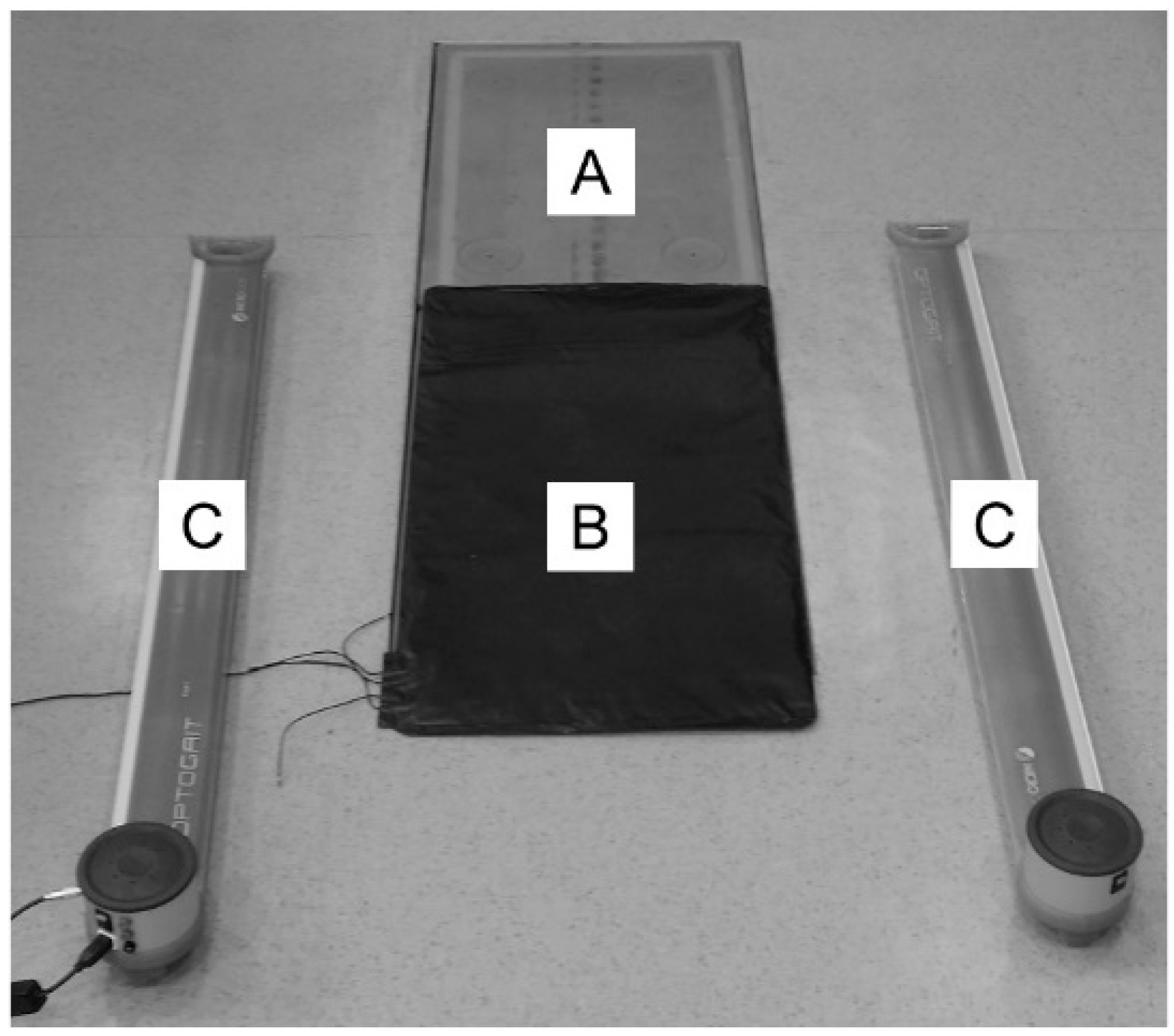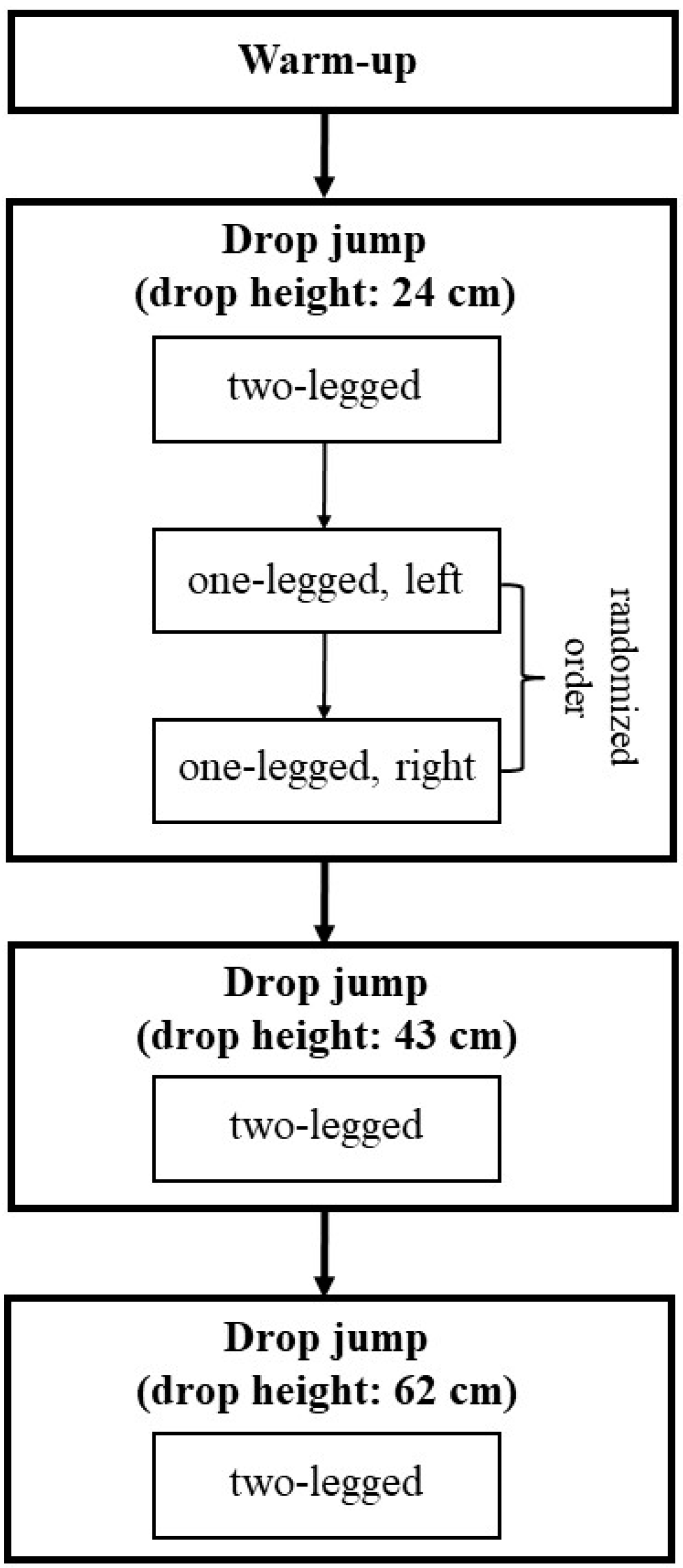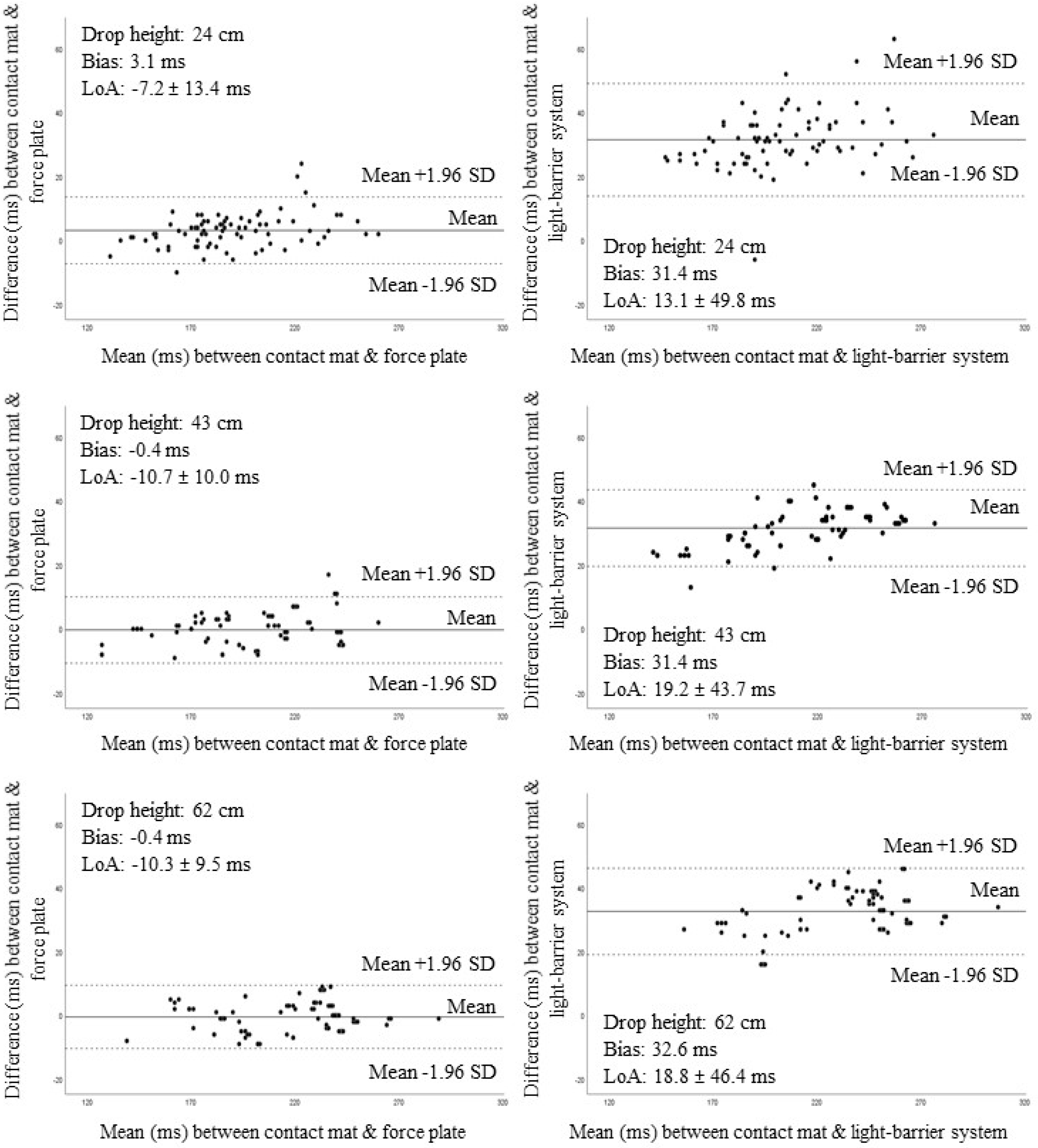Validity and Reliability of an Electronic Contact Mat for Drop Jump Assessment in Physically Active Adults
Abstract
:1. Introduction
2. Materials and Methods
2.1. Participants
2.2. Jump Task
2.3. Experimental Setup
2.4. Test Procedure
2.5. Statistical Analysis
3. Results
3.1. Concurrent Validity
3.2. Test–Retest Reliability
3.3. Minimal Detectable Change
4. Discussion
4.1. Concurrent Validity
4.2. Test–Retest Reliability
4.3. Minimal Detectable Change
5. Conclusions
Author Contributions
Funding
Conflicts of Interest
References
- Gissis, I.; Papadopoulos, C.; Kalapotharakos, V.I.; Sotiropoulos, A.; Komsis, G.; Manolopoulos, E. Strength and speed characteristics of elite, subelite, and recreational young soccer players. Res. Sports Med. 2006, 14, 205–214. [Google Scholar] [CrossRef] [PubMed]
- Coh, M.; Mackala, K. Differences between the elite and subelite sprinters in kinematic and dynamic determinations of countermovement jump and drop jump. J. Strength Cond. Res. 2013, 27, 3021–3027. [Google Scholar] [CrossRef] [PubMed]
- Bosco, C.; Ito, A.; Komi, P.V.; Luhtanen, P.; Rahkila, P.; Rusko, H.; Viitasalo, J.T. Neuromuscular function and mechanical efficiency of human leg extensor muscles during jumping exercises. Acta Physiol. Scand. 1982, 114, 543–550. [Google Scholar] [CrossRef] [PubMed]
- Kenny, I.C.; Caireallain, A.O.; Comyns, T.M. Validation of an electronic jump mat to assess stretch-shortening cycle function. J. Strength Cond. Res. 2012, 26, 1601–1608. [Google Scholar] [CrossRef] [PubMed]
- Rogan, S.; Radlinger, L.; Imhasly, C.; Kneubuehler, A.; Hilfiker, R. Validity study of a jump mat compared to the reference standard force plate. Asian J. Sports Med. 2015, 6, e25561. [Google Scholar] [CrossRef] [PubMed]
- Markwick, W.J.; Bird, S.P.; Tufano, J.J.; Seitz, L.B.; Haff, G.G. The intraday reliability of the reactive strength index calculated from a drop jump in professional men’s basketball. Int. J. Sports Physiol. Perform. 2015, 10, 482–488. [Google Scholar] [CrossRef] [PubMed]
- Menzel, H.J.; Chagas, M.H.; Szmuchrowski, L.A.; Araujo, S.R.; Campos, C.E.; Giannetti, M.R. Usefulness of the jump-and-reach test in assessment of vertical jump performance. Percept. Mot. Skills 2010, 110, 150–158. [Google Scholar] [CrossRef]
- Pueo, B.; Jimenez-Olmedo, J.M.; Lipinska, P.; Busko, K.; Penichet-Tomas, A. Concurrent validity and reliability of proprietary and open-source jump mat systems for the assessment of vertical jumps in sport sciences. Acta Bioeng. Biomech. 2018, 20, 51–57. [Google Scholar] [PubMed]
- Pueo, B.; Lipinska, P.; Jimenez-Olmedo, J.M.; Zmijewski, P.; Hopkins, W.G. Accuracy of jump-mat systems for measuring jump height. Int. J. Sports Physiol. Perform. 2017, 12, 959–963. [Google Scholar] [CrossRef] [PubMed]
- Koo, T.K.; Li, M.Y. A guideline of selecting and reporting intraclass correlation coefficients for reliability research. J. Chiropr. Med. 2016, 15, 155–163. [Google Scholar] [CrossRef] [PubMed]
- Bland, J.M.; Altman, D.G. Statistical methods for assessing agreement between two methods of clinical measurement. Lancet 1986, 1, 307–310. [Google Scholar] [CrossRef]
- Atkinson, G.; Nevill, A.M. Statistical methods for assessing measurement error (reliability) in variables relevant to sports medicine. Sports Med. 1998, 26, 217–238. [Google Scholar] [CrossRef]
- Weir, J.P. Quantifying test-retest reliability using the intraclass correlation coefficient and the SEM. J. Strength. Cond. Res. 2005, 19, 231–240. [Google Scholar] [CrossRef] [PubMed]
- Fleiss, J.L. Reliability of measurement. The Design and Analysis of Clinical Experiments; John Wiley & Sons, Inc: New York, NY, USA, 1986. [Google Scholar]
- Lin, L.I. A concordance correlation coefficient to evaluate reproducibility. Biometrics 1989, 45, 255–268. [Google Scholar] [CrossRef] [PubMed]
- Stokes, M. Reliability and repeatability of methods for measuring muscle in physiotherapy. Physiotherapy Practice 1985, 1, 71–76. [Google Scholar] [CrossRef]
- Haley, S.M.; Fragala-Pinkham, M.A. Interpreting change scores of tests and measures used in physical therapy. Phys. Ther. 2006, 86, 735–743. [Google Scholar] [PubMed]
- Cohen, J. Statistical Power for the Behavioral Sciences; Erlbaum: Hillsdale, NJ, USA, 1988. [Google Scholar]
- Feldmann, C.R.; Weiss, L.W.; Schilling, B.K.; Whitehead, P.N. Association of drop vertical jump displacement with select performance variables. J. Strength. Cond. Res. 2012, 26, 1215–1225. [Google Scholar] [CrossRef] [PubMed]
- Byrne, D.J.; Browne, D.T.; Byrne, P.J.; Richardson, N. Interday reliability of the reactive strength index and optimal drop height. J. Strength. Cond. Res. 2017, 31, 721–726. [Google Scholar] [CrossRef] [PubMed]
- Simpson, J.D.; Miller, B.L.; O’Neal, E.K.; Chander, H.; Knight, A.C. Ground reaction forces during a drop vertical jump: Impact of external load training. Hum. Mov. Sci. 2018, 59, 12–19. [Google Scholar] [CrossRef] [PubMed]
- Zemkova, E.; Hamar, D. The effect of 6-week combined agility-balance training on neuromuscular performance in basketball players. J. Sports Med. Phys. Fitness 2010, 50, 262–267. [Google Scholar] [PubMed]



| Characteristic | Force Plate | OptoGait® | Contact Mat | ||||||
|---|---|---|---|---|---|---|---|---|---|
| Test | Retest | p-/d-Value | Test | Retest | p-/d-V | Test | Retest | p-/d-Value | |
| Drop height: 24 cm | |||||||||
| two-legged | 189.2 ± 29.3 | 189.5 ± 30.8 | .91/.01 | 217.6 ± 30.9 | 219.8 ± 29.5 | .41/.07 | 185.0 ± 27.6 | 186.6 ± 29.1 | .53/.06 |
| one-legged, left | 241.0 ± 33.4 | 245.7 ± 30.9 | .05/.15 | 280.7 ± 35.7 | 287.2 ± 34.1 | .03/.19 | 237.4 ± 35.9 | 247.7 ± 30.3 | .01/.31 |
| one-legged, right | 242.6 ± 36.4 | 249.5 ± 30.8 | .08/.20 | 279.1 ± 30.9 | 288.9 ± 35.1 | .01/.29 | 239.2 ± 27.0 | 250.6 ± 31.6 | .01/.36 |
| Drop height: 43 cm | |||||||||
| two-legged | 201.4 ± 35.2 | 205.0 ± 30.0 | .10/.10 | 231.7 ± 37.8 | 236.6 ± 32.5 | .04/.13 | 200.4 ± 33.9 | 204.0 ± 28.5 | .11/.11 |
| Drop height: 62 cm | |||||||||
| two-legged | 216.3 ± 33.6 | 227.3 ± 32.8 | .01/.34 | 248.4 ± 37.3 | 256.1 ± 35.9 | .05/.21 | 214.3 ± 33.5 | 226.8 ± 33.1 | .01/.38 |
| Characteristic | Contact Mat vs. Force Plate | Contact Mat vs. OptoGait® | ||||||||
|---|---|---|---|---|---|---|---|---|---|---|
| ICC (95% CI) | Bias (ms) | LoA (ms) | Inter-Cept | Slope | ICC (95% CI) | Bias (ms) | LoA (ms) | Inter-Cept | Slope | |
| Drop height: 24 cm | ||||||||||
| two-legged | 0.98 (0.97–0.99) | 3.1 | −7.2 ± 13.4 | −0.007 (0.104) | 1.052 (<0.01) | 0.95 (0.93–0.97) | 31.4 | 13.1 ± 49.8 | 0.020 (0.006) | 1.062 (<0.01) |
| one-legged, left | 0.96 (0.94–0.97) | −0.1 | −19.7 ± 19.5 | 0.013 (0.087) | 0.947 (<0.01) | 0.95 (0.93–0.97) | 41.7 | 22.6 ± 60.8 | 0.033 (<0.01) | 1.034 (<0.01) |
| one-legged, right | 0.95 (0.93–0.97) | −0.6 | −17.7 ± 16.5 | −0.002 (0.809) | 1.009 (<0.01) | 0.97 (0.95–0.98) | 39.2 | 24.4 ± 54.1 | 0.013 (0.047) | 1.107 (<0.01) |
| Drop height: 43 cm | ||||||||||
| two-legged | 0.99 (0.98–0.99) | −0.4 | −10.7 ± 10.0 | −0.006 (0.137) | 1.027 (<0.01) | 0.98 (0.97–0.99) | 31.4 | 19.2 ± 43.7 | 0.012 (0.003) | 1.100 (<0.01) |
| Drop height: 62 cm | ||||||||||
| two-legged | 0.99 (0.98–0.99) | −0.4 | −10.3 ± 9.5 | −0.004 (0.343) | 1.016 (<0.01) | 0.98 (0.96–0.99) | 32.6 | 18.8 ± 46.4 | 0.017 (0.002) | 1.072 (<0.01) |
| Characteristic | Force Plate | OptoGait® | Contact Mat | |||||||||
|---|---|---|---|---|---|---|---|---|---|---|---|---|
| ICC (95% CI) | SEM (ms) | CV (%) | рc | ICC (95% CI) | SEM (ms) | CV (%) | рc | ICC (95% CI) | SEM (ms) | CV (%) | рc | |
| Drop height: 24 cm | ||||||||||||
| two-legged | 0.81 (0.68–0.89) | 13.0 | 5.3 | 0.81 | 0.82 (0.70–0.90) | 12.6 | 4.6 | 0.82 | 0.83 (0.71–0.90) | 11.8 | 5.1 | 0.82 |
| one-legged, left | 0.88 (0.78–0.93) | 11.3 | 3.6 | 0.87 | 0.84 (0.72–0.91) | 14.1 | 3.8 | 0.82 | 0.74 (0.58–0.85) | 17.0 | 5.1 | 0.71 |
| one-legged, right | 0.70 (0.52–0.82) | 18.4 | 4.9 | 0.69 | 0.90 (0.82–0.94) | 10.6 | 3.7 | 0.86 | 0.92 (0.86–0.95) | 8.5 | 3.9 | 0.85 |
| Drop height: 43 cm | ||||||||||||
| two-legged | 0.90 (0.83–0.94) | 10.3 | 4.3 | 0.90 | 0.90 (0.83–0.94) | 11.1 | 4.0 | 0.89 | 0.89 (0.80–0.94) | 10.5 | 4.3 | 0.88 |
| Drop height: 62 cm | ||||||||||||
| two-legged | 0.77 (0.62–0.87) | 16.1 | 6.3 | 0.73 | 0.76 (0.60–0.86) | 18.1 | 5.5 | 0.74 | 0.75 (0.59–0.85) | 16.9 | 6.4 | 0.70 |
| Characteristic | Force Plate | OptoGait® | Contact Mat |
|---|---|---|---|
| Drop height: 24 cm | |||
| two-legged | 36.0 | 34.9 | 32.7 |
| one-legged, left | 31.4 | 39.1 | 47.0 |
| one-legged, right | 50.9 | 29.4 | 23.6 |
| Drop height: 43 cm | |||
| two-legged | 28.4 | 30.6 | 29.1 |
| Drop height: 62 cm | |||
| two-legged | 44.6 | 50.1 | 46.9 |
© 2019 by the authors. Licensee MDPI, Basel, Switzerland. This article is an open access article distributed under the terms and conditions of the Creative Commons Attribution (CC BY) license (http://creativecommons.org/licenses/by/4.0/).
Share and Cite
Tenelsen, F.; Brueckner, D.; Muehlbauer, T.; Hagen, M. Validity and Reliability of an Electronic Contact Mat for Drop Jump Assessment in Physically Active Adults. Sports 2019, 7, 114. https://doi.org/10.3390/sports7050114
Tenelsen F, Brueckner D, Muehlbauer T, Hagen M. Validity and Reliability of an Electronic Contact Mat for Drop Jump Assessment in Physically Active Adults. Sports. 2019; 7(5):114. https://doi.org/10.3390/sports7050114
Chicago/Turabian StyleTenelsen, Florian, Dennis Brueckner, Thomas Muehlbauer, and Marco Hagen. 2019. "Validity and Reliability of an Electronic Contact Mat for Drop Jump Assessment in Physically Active Adults" Sports 7, no. 5: 114. https://doi.org/10.3390/sports7050114
APA StyleTenelsen, F., Brueckner, D., Muehlbauer, T., & Hagen, M. (2019). Validity and Reliability of an Electronic Contact Mat for Drop Jump Assessment in Physically Active Adults. Sports, 7(5), 114. https://doi.org/10.3390/sports7050114





